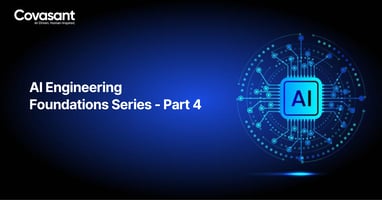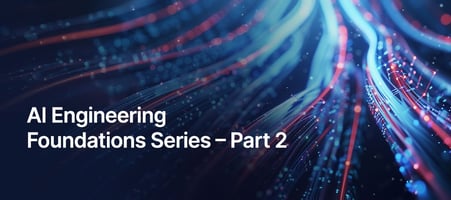Building a Future-Proof AI Operating Model – Centralized, Federated, or Hybrid?
.webp?width=941&height=529&name=Building%20a%20Future-Proof%20AI%20Operating%20Model%20%E2%80%93%20Centralized%2c%20Federated%2c%20or%20Hybrid%20(1).webp)
It is an ‘operating model’ question. And how you answer it could determine whether your AI investments will compound or fragment going forward.
Welcome to the world of AI Operating Models – the structural backbone that defines how your enterprise AI strategy scales, governs, and sustains innovation.
Why is a Future-Proof AI Operating Model Mission-Critical?
As AI becomes embedded in enterprise workflows, from marketing and customer service to supply chain and legal compliance, organizations face four critical challenges:
- Duplication of Efforts: Teams build the same LLM-based chatbot or model retraining pipeline multiple times.
- Shadow AI: Business units independently deploy GenAI tools without central oversight or AI governance.
- Non-compliance and Risk Exposure: In regulated industries, inconsistent practices lead to audit failures, hallucinations, or data leaks.
- Lack of Reusability: Hard-won AI patterns, evaluations, and feedback loops are not shared or reused across the enterprise.
Without a deliberate AI operating model, your AI efforts risk becoming siloed science experiments instead of strategic differentiators.
So, what does a good enterprise AI operating model look like?
The Three Canonical AI Operating Models Enterprises Can Explore
Most enterprises land somewhere on the spectrum between centralized, federated, and hybrid AI operating models. Each model has its own merits and trade-offs.
1. Centralized AI Operating Model
In this model, a central AI or Data Science team governs and delivers all AI use cases across business units.
Pros:
- Economies of scale, shared AI platform, tools, and talent.
- Consistent AI governance, security, and compliance.
- Easier to enforce MLOps, model registries, and evaluation frameworks.
Cons:
- Business units may see central teams as unresponsive.
- Limited domain context; central teams may struggle with deep functional nuances.
- Innovation velocity may suffer in business lines.
When to Use:
- Early stages of AI maturity.
- Regulated industries (e.g., banking, pharma).
- When governance, security, or brand risk is paramount.
Example:
A large European bank with strict model risk governance centralizes all GenAI efforts within an “AI CoE” to ensure all models are bias-audited and explainable before deployment.
2. Federated AI Operating Model
Each business unit owns and operates its AI capabilities, with light-touch governance from a central team.
Pros:
- Accelerates domain-specific innovation.
- Enables teams to move fast and prototype with local data.
- Encourages business ownership of outcomes.
Cons:
- Reinvents the wheel across teams.
- Governance becomes decentralized and harder to enforce.
- Integration into enterprise platforms is inconsistent.
When to Use:
- High AI maturity with deep domain needs.
- Industries like retail, logistics, or media where each line of business innovates rapidly.
- When agility is prioritized over control.
Example:
A global e-commerce company empowers each country team to fine-tune language models for customer service in their local language, while only loosely coordinating through shared Slack channels and templates.
3. Hybrid AI Operating Model
A central platform team builds core AI infrastructure, reusable assets, and governance frameworks. Business units consume these services and build their own use cases.
Pros:
- Best of both worlds. central control with local agility.
- Platform teams focus on horizontal assets: agent orchestration, prompt stores, LLM evaluation suites, RAG infrastructure, etc.
- Business teams focus on outcomes.
Cons:
- Requires careful ‘role clarity’ to avoid overreach or under-ownership.
- Needs strong collaboration models (product squads, shared OKRs, federated boards).
When to Use:
- Enterprise is scaling beyond pilots and needs both control and speed.
- When GenAI capabilities (e.g., LLMOps, vector database, prompt testing tools) need to be reused across 10+ teams.
- Multinational organizations have both regulatory and local innovation needs.
Example:
A Fortune 500 manufacturer deploys a hybrid model: a central “AI Platform Engineering” team maintains a secure GenAI infrastructure built on Amazon Bedrock, while regional plants build autonomous maintenance agents, leveraging shared orchestration, monitoring, and feedback tooling.
Choosing the Right AI Operating Model: A Curated Checklist
Here is a practical decision framework to guide enterprise leaders in selecting (or evolving) the right AI operating model:
|
Factor |
Considerations |
Tilt Towards |
|
AI Maturity |
AI use cases are mostly experimental or already scaled |
Centralized (early), Hybrid/Federated (mature) |
|
Domain Complexity |
Use cases deeply industry-specific or horizontal |
Federated (specific), Centralized (common) |
|
Compliance Requirements |
The org operates in regulated industries (BFSI, healthcare, etc.) |
Centralized or Hybrid |
|
Data Sensitivity |
Cross-department data sharing is a challenge |
Hybrid with access control |
|
Innovation Velocity |
New AI capabilities must be developed and deployed quickly |
Federated or Hybrid |
|
Talent Availability |
AI/ML talent is concentrated or spread across BUs |
Centralized (scarce), Federated (abundant) |
|
IT Landscape |
Platforms and infrastructure are centralized or fragmented |
Centralized if uniform, Hybrid if varied |
|
Change Readiness |
Business units are aligned to adopt centralized tools/workflows |
Hybrid if moderate, Federated if strong autonomy culture |
Covasant’s Perspective: A Platform-Centric, Hybrid-First Philosophy
At Covasant, we believe that the most future-proof approach is a Hybrid AI Operating Model powered by reusable platform assets and enterprise-grade AI governance.
Our suite, which includes Agent Orchestration, AI Ops, Governance, and Observability, is designed to plug into any operating model but delivers the most value when:
- AI agents are treated as products, not experiments.
- Feedback, monitoring, and evaluation are centralized, but use-case design is domain-specific.
- Compliance, audit trails, and fallback behaviors are enforced at the platform layer.
We enable enterprises to move fast without breaking things or breaking governance.
Closing Thoughts: The Model Is the Multiplier
Your AI Operating Model is your AI strategy in motion. Whether centralized for governance, federated for speed, or hybrid for scale, the model that you choose determines how quickly AI value flows across your enterprise in a safe and sustainable manner.
But choosing the right operating model is only the beginning.
What truly operationalizes AI at scale is your ability to build and manage production-grade pipelines, for classic machine learning (ML), Generative AI (GenAI), and increasingly, autonomous Agentic AI systems.
In the next blog in our AI Engineering Foundations Series, we’ll go deep into, “The Essential Guide to MLOps, LLMOps, and Agentic AI Pipelines,” where we’ll explore how to design resilient, governed, and reusable pipelines that power everything from model training and prompt tuning to autonomous agent orchestration.
Until then, here’s an important question that you must find an answer to: Is your AI operating model setting you up for experimentation or for sustained, production-grade impact?


.webp?height=200&name=Covasant_Blog_Banner_With_Author%20(1).webp)

